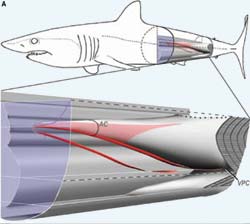Scripps Scientists Look Deep Inside Sharks and Their High-Performance Swimming System

Looks can be deceiving, the saying goes, and the same can be said of animals in the marine environment. To the casual observer, it would appear that the mighty great white shark and the common tuna don’t have a lot in common. In fact, just the opposite is true, according to new research led by scientists at Scripps Institution of Oceanography at the University of California, San Diego, and their colleagues in Germany.
In the first exploration of muscle dynamics in live lamnid sharks (a group that includes the great white and mako), the researchers found that in fact tunas and lamnids share a surprisingly close array of swimming muscle dynamics.
Scientists who study large fish in the open ocean have long noted the similarities in species that exhibit high-performance swimming mechanics, particularly those built for fast and continuous motion. For example, such swimming is exhibited in lamnid sharks, which have long been suspected of sharing a basic locomotor design with tunas.
“Tunas and lamnid sharks have a body form that represents an extreme in biomechanical design for high-performance swimming,” said Scripps’s Jeanine Donley, the first author of the study appearing in the May 6 issue of the scientific journal Nature. In fact, the research study, she says, reveals an “unprecedented level” of similarity between the two, including the dynamics of steady swimming and functional design of their complex locomotor systems.
The researchers set out to investigate the evolutionary crossroads between lamnid sharks and tunas in regards to the mechanics and architecture of their muscle-tendon systems. Recent research has uncovered a muscle design in tunas that separate them from their related “bony” fishes (see http://scrippsnews.ucsd.edu/pressreleases/shadwick_tuna1.cfm). But similar investigations probing the biomechanical designs of lamnid sharks had not been successful, mainly due to the extreme difficulty in studying such large, elusive and dangerous predators.
“As apex predators in the ocean these sharks are important and becoming rare,” said study coauthor Robert Shadwick, a professor in the Marine Biology Research Division at Scripps. “In this study we have found that lamnid sharks have diverged from their shark ancestors in the mechanical design of their swimming apparatus, just as tunas diverged from their bony fish ancestors in much the same way over the last 50 million years or so.”
Donley and her colleagues used several research methods during the study. These included analyzing video recordings of mako sharks in a swim tunnel (see video). They also used a device called a sonomicrometer to precisely record muscle shortening and lengthening during swimming activity. And they used an array of computer-based techniques to explore the three-dimensional characteristics of shark tendons and how they connect to muscles.
The combined results, which remarkably matched similar studies in tunas, displayed a unique biomechanical design in which powerful red muscles in the front of lamnid sharks transfer energy to the tail region. This high-performance muscle system serves for powerful swimming propulsion, not unlike a natural, thrust-producing hydrofoil.
“It’s interesting because the area of the body that is producing this motion is not the same area of the body that is moving back and forth-it’s physically separated,” said Donley. “It’s exactly like tuna in that respect.”
The authors say these characteristics distinguish lamnid sharks and tunas from virtually all other fish and arose independently in each, most likely the result of evolutionary selection for fast and continuous locomotion. Shadwick says in this respect lamnids and tunas are more like each other than they are to their closest relatives.
The authors believe the study shows that not only have the physical demands of the external environment sculpted the body shapes of these species, but also the internal physiology and “morphology,” or form and structure, of their complex locomotor systems have been fine-tuned over the course of their evolution.
“Sharks and bony fishes have been separated for over 400 million years and yet we see one group of sharks and one group of bony fish that share a remarkable host of similarities in body form and function,” said Donley. “It’s interesting to understand how mechanical design principles influence the evolution of locomotion in these animals.” (See video) Coauthors of the research paper, in addition to Donley and Shadwick, include Chugey Sepulveda of Scripps Institution, and Peter Konstantinidis and Sven Gemballa of the University of Tübingen in Germany.
Funding for the study was provided by the National Science Foundation and the University of California Regents.
Media Contact
All latest news from the category: Life Sciences and Chemistry
Articles and reports from the Life Sciences and chemistry area deal with applied and basic research into modern biology, chemistry and human medicine.
Valuable information can be found on a range of life sciences fields including bacteriology, biochemistry, bionics, bioinformatics, biophysics, biotechnology, genetics, geobotany, human biology, marine biology, microbiology, molecular biology, cellular biology, zoology, bioinorganic chemistry, microchemistry and environmental chemistry.
Newest articles

Combatting disruptive ‘noise’ in quantum communication
In a significant milestone for quantum communication technology, an experiment has demonstrated how networks can be leveraged to combat disruptive ‘noise’ in quantum communications. The international effort led by researchers…

Stretchable quantum dot display
Intrinsically stretchable quantum dot-based light-emitting diodes achieved record-breaking performance. A team of South Korean scientists led by Professor KIM Dae-Hyeong of the Center for Nanoparticle Research within the Institute for…

Internet can achieve quantum speed with light saved as sound
Researchers at the University of Copenhagen’s Niels Bohr Institute have developed a new way to create quantum memory: A small drum can store data sent with light in its sonic…





















